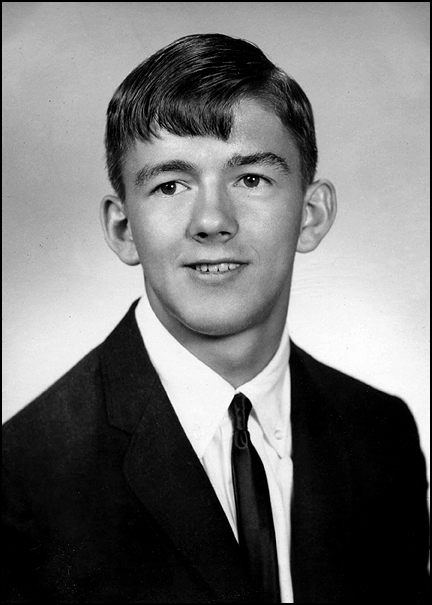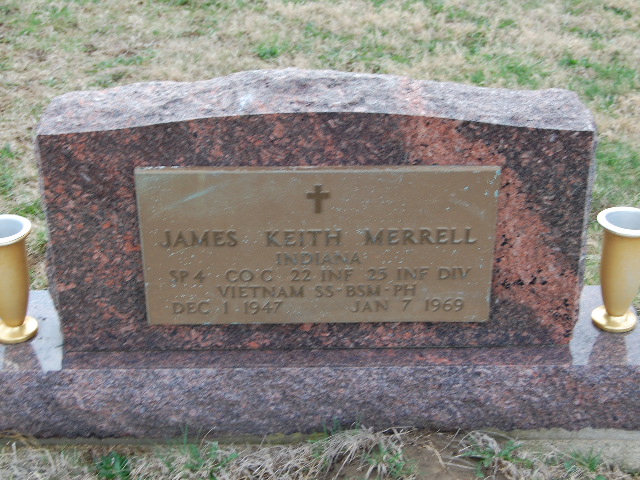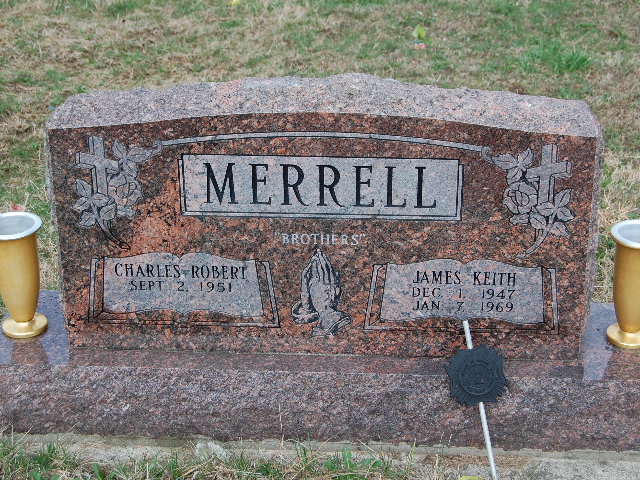************************************
Parents: Jean and Blanch (Kelly) Merrell.
Siblings: Joann (Mrs. Jerry) Herbert and Brothers Charles Merrell of Milroy, IN and William R. ”Bill" Merrell of Rushville.
***********************************
James Keith Merrell
Specialist Four
C CO, 3RD BN, 22ND INFANTRY, 25TH INF DIV, USARV
Army of the United States
Milroy, Indiana
December 01, 1947 to January 07, 1969 (21 years old)
JAMES K MERRELL is on the Wall at Panel 35W Line 049
************************************
James Keith Merrell
Specialist Four
PERSONAL DATA
Home of Record: Milroy, IN
Date of birth: 12/01/1947
MILITARY DATA
Service: Army of the United States
Grade at loss: E4
Rank: Specialist Four
ID No: 55945729
MOS: 11B20: Infantryman
Length Service: 01
Unit: C CO, 3RD BN, 22ND INFANTRY, 25TH INF DIV, USARV
CASUALTY DATA
Start Tour: 09/24/1968
Casualty Date: 01/07/1969
Incident Date: 01/07/1969
Age at Loss: 21
Location: Tay Ninh Province, South Vietnam
Remains: Body recovered
Casualty Type: Hostile, died outright
Casualty Reason: Ground casualty
ON THE WALL Panel 35W Line 049
THE VIRTUAL WALL ® www.VIRTUALWALL.org
+++++++++++++++++++++++++++++++++++++
On 07 Jan 1969 a platoon from C Company, 3/22nd Infantry, was engaged northeast of Tay Ninh City, about 8 miles from the Cambodian border. Five men died in the firefight and a sixth died three days afterwards from wounds received:
1LT Leo R. Mullen, Providence, RI;
SGT Robert J. Bowlin, Sparta, IL;
SP4 William Francisco, Summit, NJ (DoW 01/10/1969);
SP4 James K. Merrell, Milroy, IN;
SP4 Craig S. Olson, Osseo, WI; and
SP4 Danny R. Scott, Fort Worth, TX.
A seventh soldier was missing in action. Sergeant Larry D. Welsh, of Kansas City, Kansas, who had been lightly wounded during the fight, disappeared while seeking aid for another wounded soldier. Although one wounded soldier and the body of another were recovered when US forces returned to the area the following day Sergeant Welsh was not found. He was carried as Missing in Action until 11 Feb 1974, when the Secretary of the Army approved a Presumptive Finding of Death.
SGT Welsh's platoon was engaged in a firefight with the Viet Cong on 7 Jan 1969 NW of Tay Ninh City, Tay Ninh province about 8 miles from the border of South Vietnam and Cambodia. SGT welsh sustained a minor injury from shrapnel. He told another wounded soldier that he was going for help. The soldier observed SGT Welsh walk down a path toward an area that artillery was hitting. The next day a search team recovered and identified one American dead and the wounded soldier SGT Welsh had contact with. The search team found SGT Welsh's eyeglasses, wallet, shirt and a special silver chain wristband watch he wore. SGT Welsh was not found. SGT Welsh was the only American unaccounted for that day in Vietnam. SGT Welsh's family believes that he was taken prisoner by the Viet Cong. They have written letters and sent packages and all have been returned unopened. SGT Welsh is from Kansas City, Kansas and worked for the Santa Fe Railroad before enlisting in the army. The Santa Fe Railroad is still holding his job. God bless you SGT, where ever you are, we will pray for your return to your native soil.
+++++++++++++++++++++++++++++++++++++
3rd Battalion, 22nd Infantry (4th Infantry Division and 25th Infantry Division)
Stationed at Ft. Lewis, WA. in early 1960's. Departed Tacoma, WA. 22 September 1966 (Deployed to Vietnam from Ft. Lewis, WA. serving with the 4th Infantry Division until transferred to the 25th Infantry Division on 01 August 1967.) Arrived Vietnam 09 October 1966; Bear Cat October 1966 to November 1966; Dau Tieng December 1966 to June 1967; Pleiku July 1967; transferred to the 25th Infantry Division 01 August 1967; Cu Chi/Tay Ninh August 1967 to February 1968; Dau Tieng/Hoc Mon July 1968; Dau Tieng/Saigon August 1968 to October 1968; Dau Tieng November 1968 to June 1969; Dau Tieng/ Cu Chi July 1969; Cu Chi/Boa Trai August 1969 to January 1970; Tay Ninh February 1970 to April 1970; Thien Ngon May 1970; Katum June 1970; Tay Ninh July 1970; Dau Tieng August 1970; Tri Tam September 1970; Dau Tieng October 1970 to November 1970; Xuan Loc December 1970; Xuan Loc/ Long Binh Janurary 1971 to 20 April 1971; Returned to U.S.A. at Ft. Carson, CO.
Units of the Regiment distinguished themselves in the dense jungles of the central highlands as part of the 4th Infantry Division and in the hotly contested areas west of Saigon as part of the 25th Infantry Division. The 2nd and 3rd Battalions earned the Presidential Unit Citation for their actions at the Battle of Soui Tre.
++++++++++++++++++++++++++++++++++++
Vietnam - 22nd Infantry Regiment Society
The below information from the 22nd Infantry Regiment during the time SPC James Keith Merrell was assigned to C/22 Inf, 25th ID.
Counteroffensive, Phase V, 1 July 1968 - 1 November 1968. During this period a country-wide effort was begun to restore government control of territory lost to the enemy since the Tet offensive. The enemy attempted another such offensive on 17-18 August but his efforts were comparatively feeble and were quickly overwhelmed by Allied forces.
In the fall of 1968 the South Vietnamese government, with major U.S. support, launched an accelerated pacification campaign. All friendly forces were coordinated and brought to bear on the enemy in every tactical area of operation. In these intensified operations, friendly units first secured a target area, then Vietnamese government units, regional forces/popular forces, police and civil authorities screened the inhabitants, seeking members of the Viet Cong infrastructure. This technique was so successful against the political apparatus that it became the basis for subsequent friendly operations. Government influence expanded into areas of the countryside previously dominated by the Viet Cong to such an extent that two years later at least some measure of government control was evident in all but a few remote regions.
Counteroffensive, Phase VI, 2 November 1968 - 22 February 1969. In November 1968 the South Vietnam government with American support began a concentrated effort to expand security in the countryside. This project was known as the "Accelerated Pacification Campaign."
This period covers the election of President Richard M. Nixon and a change of policy brought about by his administration after January 1969 when he announced a coming end to US combat in Southeast Asia and a simultaneous strengthening of South Vietnam's ability to defend itself. Formal truce negotiations began in Paris on January 25, 1969. The period can be characterized as marking time in preparation for an about face. Forty-seven ground combat operations were recorded during this period.
++++++++++++++++++++++++++++++++++++
I sent an e-mail to the C/3Bn/22Inf Association to see if any additional information on James could be found and if anyone knew what actions he did to receive the Silver Star.
BILL SCHWINDT (Locator/Chaplain), 1965-67, 4TH PLT, 4468 SE WHITE LAKE RD., MILWAUKIE, OR 97222 wrote me saying "Perhaps one of Merrill's friends will respond to your message and be able to tell you about the silver star. I don't even know if it was awarded for action the day he was killed or not. However, I suspect it was. Second hand story, but I was told several of our KIAs that day (5) had voluntered to go retrieve a wounded guy or body up front."
http://www.c322association.org
William Harter ws probably killed at Ap Cho. Most all the battalion was at Ap Cho on various days around that time. We had 2 killed on 2-10-68 there. So I'm guessing, but it's a good guess. Ap Cho was a village that the NVA had built concrete bunkers in. They planned on staying. Ap Cho village was right on a main convoy road and no convoy's could get through with the NVA in there. It was our job to get them out and this was right after Tet, so artillery support was slight, because they were so busy.
One of our guys wrote a book about Ap Cho. I think it's still available. You might take a look on our website in the PX part.
Bill Schwindt in Portland OR
C3/22 Infantry 66-67
[email protected]
************************************
Parents: Jean and Blanch (Kelly) Merrell.
Siblings: Joann (Mrs. Jerry) Herbert and Brothers Charles Merrell of Milroy, IN and William R. ”Bill" Merrell of Rushville.
***********************************
James Keith Merrell
Specialist Four
C CO, 3RD BN, 22ND INFANTRY, 25TH INF DIV, USARV
Army of the United States
Milroy, Indiana
December 01, 1947 to January 07, 1969 (21 years old)
JAMES K MERRELL is on the Wall at Panel 35W Line 049
************************************
James Keith Merrell
Specialist Four
PERSONAL DATA
Home of Record: Milroy, IN
Date of birth: 12/01/1947
MILITARY DATA
Service: Army of the United States
Grade at loss: E4
Rank: Specialist Four
ID No: 55945729
MOS: 11B20: Infantryman
Length Service: 01
Unit: C CO, 3RD BN, 22ND INFANTRY, 25TH INF DIV, USARV
CASUALTY DATA
Start Tour: 09/24/1968
Casualty Date: 01/07/1969
Incident Date: 01/07/1969
Age at Loss: 21
Location: Tay Ninh Province, South Vietnam
Remains: Body recovered
Casualty Type: Hostile, died outright
Casualty Reason: Ground casualty
ON THE WALL Panel 35W Line 049
THE VIRTUAL WALL ® www.VIRTUALWALL.org
+++++++++++++++++++++++++++++++++++++
On 07 Jan 1969 a platoon from C Company, 3/22nd Infantry, was engaged northeast of Tay Ninh City, about 8 miles from the Cambodian border. Five men died in the firefight and a sixth died three days afterwards from wounds received:
1LT Leo R. Mullen, Providence, RI;
SGT Robert J. Bowlin, Sparta, IL;
SP4 William Francisco, Summit, NJ (DoW 01/10/1969);
SP4 James K. Merrell, Milroy, IN;
SP4 Craig S. Olson, Osseo, WI; and
SP4 Danny R. Scott, Fort Worth, TX.
A seventh soldier was missing in action. Sergeant Larry D. Welsh, of Kansas City, Kansas, who had been lightly wounded during the fight, disappeared while seeking aid for another wounded soldier. Although one wounded soldier and the body of another were recovered when US forces returned to the area the following day Sergeant Welsh was not found. He was carried as Missing in Action until 11 Feb 1974, when the Secretary of the Army approved a Presumptive Finding of Death.
SGT Welsh's platoon was engaged in a firefight with the Viet Cong on 7 Jan 1969 NW of Tay Ninh City, Tay Ninh province about 8 miles from the border of South Vietnam and Cambodia. SGT welsh sustained a minor injury from shrapnel. He told another wounded soldier that he was going for help. The soldier observed SGT Welsh walk down a path toward an area that artillery was hitting. The next day a search team recovered and identified one American dead and the wounded soldier SGT Welsh had contact with. The search team found SGT Welsh's eyeglasses, wallet, shirt and a special silver chain wristband watch he wore. SGT Welsh was not found. SGT Welsh was the only American unaccounted for that day in Vietnam. SGT Welsh's family believes that he was taken prisoner by the Viet Cong. They have written letters and sent packages and all have been returned unopened. SGT Welsh is from Kansas City, Kansas and worked for the Santa Fe Railroad before enlisting in the army. The Santa Fe Railroad is still holding his job. God bless you SGT, where ever you are, we will pray for your return to your native soil.
+++++++++++++++++++++++++++++++++++++
3rd Battalion, 22nd Infantry (4th Infantry Division and 25th Infantry Division)
Stationed at Ft. Lewis, WA. in early 1960's. Departed Tacoma, WA. 22 September 1966 (Deployed to Vietnam from Ft. Lewis, WA. serving with the 4th Infantry Division until transferred to the 25th Infantry Division on 01 August 1967.) Arrived Vietnam 09 October 1966; Bear Cat October 1966 to November 1966; Dau Tieng December 1966 to June 1967; Pleiku July 1967; transferred to the 25th Infantry Division 01 August 1967; Cu Chi/Tay Ninh August 1967 to February 1968; Dau Tieng/Hoc Mon July 1968; Dau Tieng/Saigon August 1968 to October 1968; Dau Tieng November 1968 to June 1969; Dau Tieng/ Cu Chi July 1969; Cu Chi/Boa Trai August 1969 to January 1970; Tay Ninh February 1970 to April 1970; Thien Ngon May 1970; Katum June 1970; Tay Ninh July 1970; Dau Tieng August 1970; Tri Tam September 1970; Dau Tieng October 1970 to November 1970; Xuan Loc December 1970; Xuan Loc/ Long Binh Janurary 1971 to 20 April 1971; Returned to U.S.A. at Ft. Carson, CO.
Units of the Regiment distinguished themselves in the dense jungles of the central highlands as part of the 4th Infantry Division and in the hotly contested areas west of Saigon as part of the 25th Infantry Division. The 2nd and 3rd Battalions earned the Presidential Unit Citation for their actions at the Battle of Soui Tre.
++++++++++++++++++++++++++++++++++++
Vietnam - 22nd Infantry Regiment Society
The below information from the 22nd Infantry Regiment during the time SPC James Keith Merrell was assigned to C/22 Inf, 25th ID.
Counteroffensive, Phase V, 1 July 1968 - 1 November 1968. During this period a country-wide effort was begun to restore government control of territory lost to the enemy since the Tet offensive. The enemy attempted another such offensive on 17-18 August but his efforts were comparatively feeble and were quickly overwhelmed by Allied forces.
In the fall of 1968 the South Vietnamese government, with major U.S. support, launched an accelerated pacification campaign. All friendly forces were coordinated and brought to bear on the enemy in every tactical area of operation. In these intensified operations, friendly units first secured a target area, then Vietnamese government units, regional forces/popular forces, police and civil authorities screened the inhabitants, seeking members of the Viet Cong infrastructure. This technique was so successful against the political apparatus that it became the basis for subsequent friendly operations. Government influence expanded into areas of the countryside previously dominated by the Viet Cong to such an extent that two years later at least some measure of government control was evident in all but a few remote regions.
Counteroffensive, Phase VI, 2 November 1968 - 22 February 1969. In November 1968 the South Vietnam government with American support began a concentrated effort to expand security in the countryside. This project was known as the "Accelerated Pacification Campaign."
This period covers the election of President Richard M. Nixon and a change of policy brought about by his administration after January 1969 when he announced a coming end to US combat in Southeast Asia and a simultaneous strengthening of South Vietnam's ability to defend itself. Formal truce negotiations began in Paris on January 25, 1969. The period can be characterized as marking time in preparation for an about face. Forty-seven ground combat operations were recorded during this period.
++++++++++++++++++++++++++++++++++++
I sent an e-mail to the C/3Bn/22Inf Association to see if any additional information on James could be found and if anyone knew what actions he did to receive the Silver Star.
BILL SCHWINDT (Locator/Chaplain), 1965-67, 4TH PLT, 4468 SE WHITE LAKE RD., MILWAUKIE, OR 97222 wrote me saying "Perhaps one of Merrill's friends will respond to your message and be able to tell you about the silver star. I don't even know if it was awarded for action the day he was killed or not. However, I suspect it was. Second hand story, but I was told several of our KIAs that day (5) had voluntered to go retrieve a wounded guy or body up front."
http://www.c322association.org
William Harter ws probably killed at Ap Cho. Most all the battalion was at Ap Cho on various days around that time. We had 2 killed on 2-10-68 there. So I'm guessing, but it's a good guess. Ap Cho was a village that the NVA had built concrete bunkers in. They planned on staying. Ap Cho village was right on a main convoy road and no convoy's could get through with the NVA in there. It was our job to get them out and this was right after Tet, so artillery support was slight, because they were so busy.
One of our guys wrote a book about Ap Cho. I think it's still available. You might take a look on our website in the PX part.
Bill Schwindt in Portland OR
C3/22 Infantry 66-67
[email protected]
Sponsored by Ancestry
Advertisement
Advertisement







